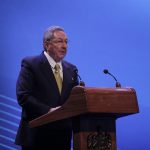Young people, under the banner of “non-violence”, and employing logos and marketing tactics, which attract young people, should foment small riots in the street, to create a permanent environment of instability and chaos.
Then, attracting the attention of the international media, and guided by Washington agencies, they seek to provoke the repression of the security forces, through violent or illegal acts, an image that is subsequently projected through the press as a violation of human rights, and used to justify any action against the government.
This is how the so-called “soft strokes” manifest themselves. Its essences, described in the article Soft Hit: USA Strategy to Change Systems, published by this means on the 1st. December, they are part of the script of what happened in San Isidro, and of the steps that some of those who went to the Ministry of Culture (Mincult) followed.
While the members of the group from the Havana neighborhood used contempt and assumed a posture of force so that their demands were met, those who reached the Mincult staged a peaceful demonstration, which included, above all, intellectuals and artists, but which it was deliberately contaminated by those who, previously instructed, raised a variety of concerns and ideas and demands.
However, although there was a meeting with ministerial authorities and the organizations that bring together intellectuals and artists in Cuba; Although there was a group of agreements emanating from it, immediately afterwards, the generation of content associated with the issue began on social networks and on the pages of recognized anti-Cuban media, intended to discredit the validity of the meeting, thus promoting feelings of discontent, frustration, polarization of those involved and, of course, incitement to violence, as described in the CIA manuals.
According to a material published this Thursday in the stellar newscast of Cuban Television, the investigations showed that citizens with involvement in vandalism against stores in MLC on the island participated in that peaceful demonstration.
This was demonstrated by the testimony of Abdel Antonio Cárdenas, who assured that when the young people were already leaving the Mincult, he received a call to promote an outbreak consisting of “breaking the 11 and 4 store, ripping it to shreds, burning a policeman, doing something atrocious”.
Undoubtedly, digital platforms have become an indispensable pillar for those who, from abroad, articulate this type of action. WhatsApp groups, Telegram channels or Facebook profiles, become the contact point for the call, although their promoters often hide their identities.
In all cases, as was also made explicit in the television material, the plans envisage a foreseeable reaction from the forces of order, popular support for those involved, as well as the media amplification of the incidents.
A marked opportunism takes advantage of the complex economic situation of the country, in current moments of confrontation with the covid-19 pandemic, so that the proliferation of this type of actions can eventually generate a larger social outbreak.
The objective? Well, the same as always, to overthrow the Cuban Revolution, and destroy with it the justice and dignity with which we have known how to build our society. But they won’t.

Redacción Digital
Equipo de redactores del sitio web de Radio Mayabeque



